I’ve wrapped up my stay in Tonga for the 2012 season, and I’ve commenced the long journey back to Asia.
Once I'm back and settled, I’ll do my best to crank out a summary of this season’s calf IDs. The good news is that it’s looking very likely that we’ll surpass 50 calf IDs. Seriously!
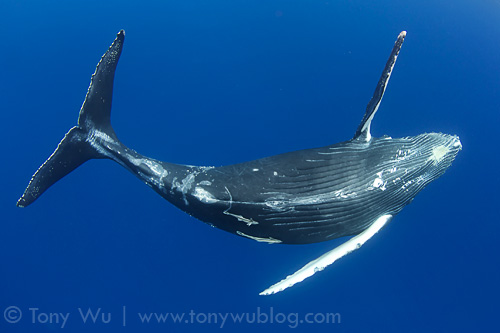
Male humpback whale calf (#42) playing in the blue
The only reason I hesitate in being more definitive is that with so many mother/ calf pair ID candidates, I’m allowing for the fact that I may have made mistakes or double-counted somewhere along the way. I caught one error early on, so it only(!) cost me 2.5 hours of work to fix it.
As you can imagine, the more calf IDs there are, the more difficult it becomes to check every new calf against all the previous ones. As the season wore on, I spent two to three hours each night cross-checking photos...most of the time in a cross-eyed, discombobulated state of exhaustion.
Fortunately, I’ve had a lot of practice doing this for many seasons, and I have a (mostly) logical system set up to help minimise obvious error.
I’m hoping to finish and post my calf count summary file in relatively short order, though the sheer number of IDs (still increasing) plus a series of upcoming events are conspiring against me: (a) I need to head out for my next trip in early November; (b) I am giving a talk about whales in Osaka (in Japanese...yikes!) on 26 October; and (c) I’m preparing a presentation about my annual calf ID count to be given by Allan Bowe at Whale Fest in the UK the weekend of 27 October. (I really wanted to attend Whale Fest, but alas, it is still not possible to occupy two places in space at the same points in time.)
For the time being, please take a look at my humpback whale calf count summary file from 2011 for an idea of the daunting task ahead of me.
Half Century Mark
As I mentioned above, I’m relatively certain that we broke the 50-calf level this season.
Assuming I haven’t majorly screwed up the IDs, this is doubly amazing, as I actually wasn’t trying too hard this season.
Having hit 48 calves last year, I sorta figured that I had proven my point...that there are lots and lots of humpback whale mother/ calf pairs that pass through the waters around Vava’u each season.
One would think this wasn’t a particular point of contention, but it was for many years.
Having hit this particular ball out of the park, I was intent on concentrating on other things (calf sex ratio, escort behaviour, unique physical trait appearances, etc.) this season, while continuing the calf count more for fun than anything else.
Well, so much for that.
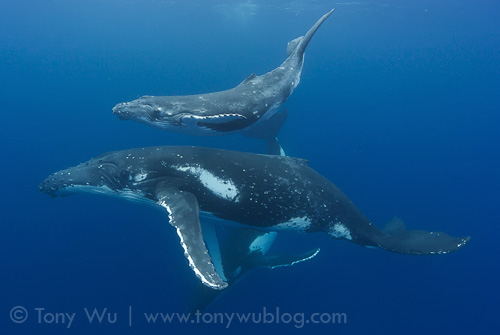
Male calf (#46) with mommy and escort (one of two)
Subject to going through all the photos and associated information more carefully, here are some of the likely highlights to come out of this year’s data:
- The calf/ boat-day ratio, which is my indicator of “calf density” as it were, will be significantly higher this year than in any other year, including 2011. What this seems to suggest is that in addition to the absolute number of calf IDs being high, the mother/ calf pair density through the season here was perhaps the highest since I commenced counting. I’ll explain more about how and why I calculate this figure when I post my summary, but if you’re interested, I’ve defined and calculated this ratio for past seasons and included the figures in an easy-to-understand graph in my 2011 summary.
- There will, once again, be more female calves than males (among the calves for which I was able to determine sex). The ratio has favoured females in every season since I began keeping track. There is always the possibility of sheer coincidence, but given that this has been the case for four seasons running now, I’m feeling more certain that there is some significance to this.
- We did not see any “long stay” mother/ calf pairs as we did in 2010 and 2011. The whales were transient (which actually seems to be the norm).
- We did not see any calves with injuries akin to the those on calf 201114 Tahafa and several other baby whales in the 2011 season. This suggests that whatever was lurking in the neighborhood pouncing on the little ones last year (I guessed false killer whales) was not present this year.
- We did not document any long-term escort-to-mother/ calf pair associations as we did in 2011. If you think about it, this make sense, given point 3. Since we didn’t have multiple encounters with a given mother/ calf pair over a long period of time, it follows that we didn’t see any accompanying escorts over an extended period.
Once, Twice, Three Times A Mommy
In addition to these summary points, we documented our first 3x mother!
The mother of 200816 Chibi was the mother of 200929 Floppy (female) is the mother of 201247 Yonjuunana (tentative ID).
You can see the previous calf IDs in my previous summary files (2008 humpback whale calf IDs; 2009 humpback whale calf IDs).
Even more exciting is that I was only able to document this 3x mother due to the help of three other people: Nonie Silver and Karen Stone in 2009; and Kirsty Bowe in 2012. I made the original ID in 2008, but in both 2009 and 2012, I did not photograph the mother. These three women did.
I’ve been rambling on for years about the value of working together and making use of technology to leverage individual efforts. This is a perfect example!
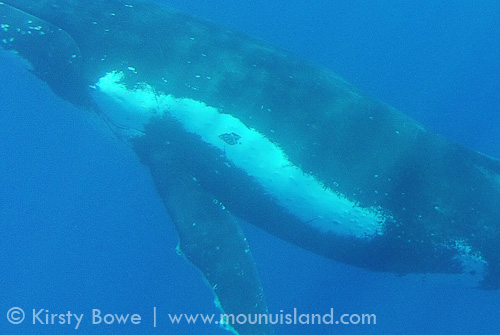
Distinctive body print of female humpback that is a 3x mother
Total Bummer
We also had one bummer of an experience concerning a calf on 4 October.
In North Bay, we came across a lone calf with no mother or other adult whales in sight. I managed to get a few photos for ID purposes, so I know that it wasn’t a calf I had seen before.
The sad fact though, is that there is no hope for the calf.
Humpback whale babies rely 100% on their mothers for sustenance and protection. Without her around, the calf is doomed.
There was also a calf that stranded in Ha’apai earlier in the season. Though people there banned together to re-float the little whale, there was, as I understand, no mother in the vicinity...so it’s almost certain that the calf concerned also did not make it.
I’ve written in the past about calf separations; it’s not a new topic or experience for me. It’s always depressing to see a calf whose days are numbered, but it’s best to call a spade a spade and recognise that calf separations are most likely a normal occurrence.
We can certainly discuss and debate the possible causes underlying such a tragic turn of events, but there is zero point being wishy-washy and sugar-coating the issue with false hope and denial.
White Pecs
As of now, my White Pec count stands at 20 individuals.
In case you’re not familiar with what I’m referring to...the term White Pec is what I use to describe whales that have white on both the dorsal and ventral surfaces of their pectoral fins.
This is a common pigmentation pattern in the northern hemisphere. It exists down south as well, but it’s not as prevalent as up north.
Now...the reason I’m paying attention to this is that I first noticed such whales here in reasonable quantity during the 2006 season. Up until that point, I had never seen one, or if I had, I did not take note (nor had any of my friends...I asked around).
From 2007 to 2010, I didn’t see many, if any, each season.
Then in 2011, I recorded 10. And now in 2012, I have 20.
As a subset of the total count, I recorded my first two calves with white pectoral fins in 2011 (never saw/ noticed any before), and I have 9 calves with such pigmentation this season.
Hmmmmm.
Maybe there’s nothing to this, but it does make me wonder why such an obvious physical trait should be present in substantial quantity in a given season, but not in others. And also why calves with this pigmentation should suddenly appear in 2011, then show up in significant quantity in 2012.
And of course, it makes me wonder what will happen next year.
Earlier in the season, I made reference to the possibility that this outward physical trait may reflect an underlying genetic link, that perhaps the White Pecs are relatively closely related. If this were the case (which is far from certain), then perhaps these somewhat-related animals travel in loose association with one another.
If I had access to biopsy darts and a genetics lab, it’d be pretty easy to test for a possible genetic link, assuming the White Pecs show up again.
Lacking access to those things, I’m doing the next best thing I can think of, which is to use photos to track obvious physical traits and look for possible patterns.
As if the annual calf count weren’t time-consuming enough...I have to find time to go back through all my digital photos from 2005 onward (argh, argh, argh...not even going to contemplate trawling through film files) and dig out the White Pecs (as well as whales with split dorsal fins) to compile a summary of sightings over the 2005-2012 period.
Given my hectic travel schedule, I’m not sure when I’ll be able to do this, but I’ll do my best to hit the RAW files again at year end when everyone else is drinking and being merry. Sigh...what I wouldn’t give for some helper elves.
Oh...speaking of White Pecs, we had our first long-term, in-season re-sighting of a White Pec. A male White Pec that was part of an 11-whale heat run on 31 August appeared again on 25 September as an escort to a mother/ calf pair (one that I haven’t assigned an ID to yet).
Exhilarating stuff for a whale geek like me.
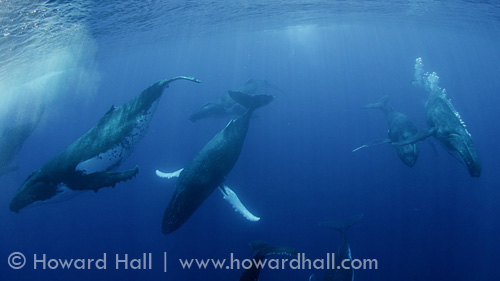
Screen grab from video footage:
White Pec humpback in an 11-whale heat run on 31 Aug
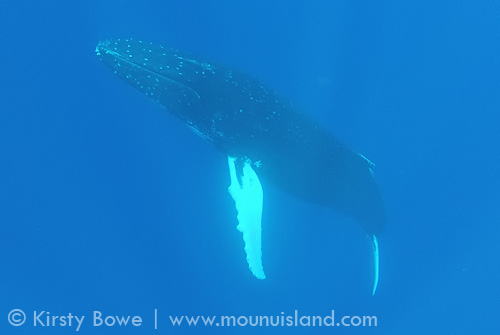
Second sighting of the same White Pec whale on 25 September
Perfect People
I’m already pretty drained from the travel process (what’s not to love about schlepping baggage around, being asked to un-pack/ re-pack bags several times, lounging around in airport after airport, enduring the contortions of airplane seats, etc.), so I’m going to wrap this up and get another shot of caffeine to help me make it through the rest of the trip.
I do however want to take this opportunity to say “Thank You!!! (and thanks for putting up with me)” to everyone I spent time with during the season. The list is long and distinguished.
Once again, I had the privilege of spending time with incredibly fun, kind, intelligent, and accomplished people from many different walks of life...all of whom I hope will be life-long friends.
That’s it for now. Thanks for reading, and stay tuned for the 2012 calf count summary.
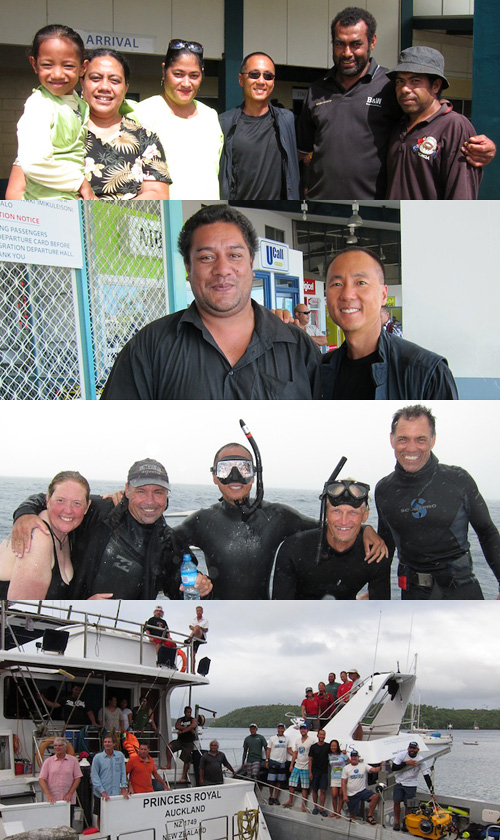
Just a few of the people who made the past two months a wonderful experience
Humpback Whales in Tonga | Part 1
Humpback Whales in Tonga | Part 2
Humpback Whales in Tonga | Part 3
Humpback Whales in Tonga | Part 4
Humpback Whales in Tonga | Part 5